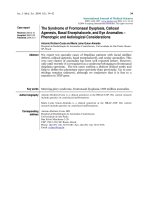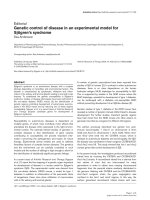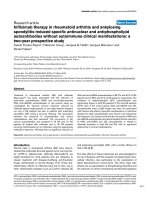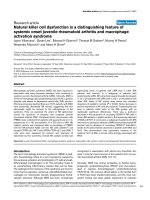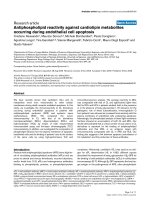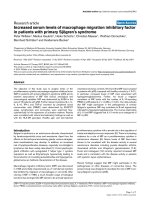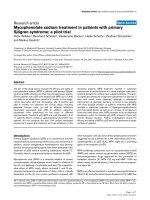Báo cáo y học: "Antiphospholipid syndrome" pot
Bạn đang xem bản rút gọn của tài liệu. Xem và tải ngay bản đầy đủ của tài liệu tại đây (295.14 KB, 9 trang )
Page 1 of 9
(page number not for citation purposes)
Available online />Abstract
Antiphospholipid syndrome is diagnosed when arterial or venous
thrombosis or recurrent miscarriages occur in a person in whom
laboratory tests for antiphospholipid antibodies (anticardiolipin anti-
bodies and/or lupus anticoagulant and/or anti-beta 2-glycoprotein I)
are positive. Despite the strong association between antiphospho-
lipid antibodies and thrombosis, their pathogenic role in the
development of thrombosis has not been fully elucidated. Novel
mechanisms involving both the complement pathway and micro-
particles have been described. The knowledge of these new patho-
genic approaches might identify novel therapeutic targets and
therefore may improve the management of these patients.
Introduction
Antiphospholipid syndrome (APS) is characterized by venous
or arterial thromboses, fetal losses and thrombocytopenia, in
the presence of antiphospholipid antibodies (aPL) (namely
lupus anticoagulant (LA)), anticardiolipin antibodies (aCL) or
antibodies directed to various proteins, mainly beta
2-glycoprotein I (β
2
GPI), or in the presence of all three [1].
Despite the strong association between aPL and thrombosis,
the pathogenic role of aPL in the development of thrombosis
has not been fully elucidated. The aPL have been implicated
in reactions that interfere with almost all known hemostatic
and endothelial cell reactions [2]. Some evidence regarding
the effect of aPL on the complement has been described
recently, and related to pregnancy complications and throm-
bosis [3]. Given the heterogeneity of clinical manifestations in
APS it is likely that more than one pathophysiological process
may play a role.
Regarding the clinical spectrum of APS, any combination of
vascular occlusive events may occur in the same individual
and the time interval between the events also varies
considerably from weeks to months or even years. Deep vein
thrombosis is the most frequently reported manifestation in
this syndrome, whereas cerebrovascular accidents are the
most common arterial thrombotic manifestations. Early and
late fetal losses, premature births and pre-eclampsia are the
most frequent fetal and obstetric manifestations [4].
Additionally, several other clinical features such as thrombo-
cytopenia, livedo reticularis, and heart valve lesions are
relatively common in these patients. Finally, a large variety of
unusual clinical manifestations, with prevalence <5%, have
been described in APS patients. These unusual manifes-
tations include, among others, large peripheral artery occlu-
sions, chorea, transverse myelopathy, adult respiratory
distress syndrome, and avascular necrosis of the bone [5].
With respect to the treatment of APS, there is consensus in
treating patients with APS and first venous thrombosis with
oral anticoagulation to a target International Normalized Ratio
of 2.0 to 3.0 [6]. A recent systematic review recommended a
target International Normalized Ratio >3.0 in the group of
patients with APS and arterial thrombosis [7]. The approach
for women with obstetric manifestations of APS is based on
the use of aspirin plus heparin [8].
The aim of the present review is focused on some recent
aspects of pathogenesis, clinical manifestations, and treat-
ment of APS.
Pathogenetic mechanisms in APS
Induction of antiphospholipid antibodies
Which are the factors involved in the production of aPL? The
aPL are not directed against phospholipids, but against a
wide variety of phospholipid-binding proteins (also named
cofactors). β
2
GPI is the most important antigenic target of
aPL [9]. Moreover, it seems that only aPL with high affinity for
β
2
GPI are pathologically relevant.
Infectious agents have been related with the production of
aPL. Many infections may be accompanied by increases in
aPL and, in some cases, by clinical manifestations of APS. It
has been shown that aPL may be synthesized by B-cell
clones cross-reacting with epitopes expressed on infectious
Review
Antiphospholipid syndrome
Gerard Espinosa and Ricard Cervera
Department of Autoimmune Diseases, Institut Clínic de Medicina i Dermatologia, Hospital Clínic, Villarroel 170, 08036 Barcelona, Catalonia, Spain
Corresponding author: Ricard Cervera,
Published: 15 December 2008 Arthritis Research & Therapy 2008, 10:230 (doi:10.1186/ar2536)
This article is online at />© 2008 BioMed Central Ltd
aCL = anticardiolipin antibodies; aPL = antiphospholipid antibodies; APS = antiphospholipid syndrome; β
2
GPI = beta 2-glycoprotein I; LA = lupus
anticoagulant; NF = nuclear factor; TLR = Toll-like receptor; TNF = tumor necrosis factor.
Page 2 of 9
(page number not for citation purposes)
Arthritis Research & Therapy Vol 10 No 6 Espinosa and Cervera
agents as the result of a molecular mimicry between
exogenous molecules and β
2
GPI [10]. Anti-β
2
GPI antibodies
have been shown to recognize β
2
GPI peptides displaying
molecular mimicry with common bacteria and viruses, both at
the level of the amino acid sequence and of the conforma-
tional structure. Such a homology was suggested to represent
the rationale for the possible infectious origin of the syndrome.
It could be possible that other environmental factors, such as
drugs or neoplasms, might be responsible for inducing aPL.
In cancer, the accumulation of many cells is a result of
excessive cell proliferation and/or insufficient apoptosis. One
of the earliest changes in cells undergoing apoptosis is the
exposure of phosphatidylserine on the outer membrane
leaflet. A key link between apoptosis and the onset of
autoimmunity is provided by autoantibodies that bind
apoptotic cells and recognize surface epitopes that include
complexes of phospholipid and β
2
GPI. It is possible that
autoantibodies to malignant cells arise secondary to changes
in the cell membrane inducing exposure of certain antigens
that are normally facing the intracellular compartment [11].
Moreover, the presence of aPL is linked to genetic pre-
disposition, which may be associated, at least in part, with
genes of the major histocompatibility complex (HLA system)
[12]. Regarding the genetics of β
2
GPI, there is evidence that
the Val247 allele may be one of the genetic risk factors for
development of APS – although the results are contradictory.
Yasuda and colleagues found that the Val247 β
2
GPI allele
was associated with both a high frequency of anti-β
2
GPI
antibodies and stronger reactivity with anti-β
2
GPI antibodies
[13]. On the other hand, Camilleri and colleagues found no
association between the Val/Leu247 polymorphism and the
presence of anti-β
2
GPI in a white population [14]. Exposure
to one or more environmental agents, such as infections, in a
genetically susceptible individual, through a molecular
mimicry, can result in the production of pathogenic aPL that
can induce thrombosis and pregnancy loss.
Another hypothesis explains the existence of natural
autoantibodies that develop for a good purpose (infectious
theory) but may evolve to become pathogenic under certain
adverse conditions such as oxidant stress. Antiphospholipid
antibodies have been found in approximately 12% of elderly
populations and in some 2% of younger populations. Some
evidence favors natural autoantibodies perhaps having
specific regulatory functions in the immune system. In
accordance with these observations, it may be possible that
autoantibodies are not pathological forms of immunity but,
under aberrant vascular conditions such as oxidant stress,
they lose their normal functions, leading to autoimmunity [15].
Pathogenic role of
ββ
2
GPI–antibody complex
β
2
GPI is a highly glycosylated single-chain protein that is
present in plasma without known physiological function. The
protein avidly binds to negatively charged phospholipids such
as cardiolipin, phosphatidylserine, or phosphatidylinositol.
Upon phospholipid binding, β
2
GPI changes conformation
and exposes a cryptic epitope to which high-affinity anti-
bodies can bind [16]. β
2
GPI is subsequently dimerized by the
autoantibodies and is probably fixed in an activated confor-
mation. Furthermore, this complex integrated by the anionic
phospholipid, β
2
GPI, and antibody is able to interact with
hemostatic reactions and several cellular receptors [17]
(Figure 1). Several animal models immunized with the co-
factor β
2
GPI developed clinical manifestations of APS,
including fetal loss, thrombocytopenia, and neurological and
behavioral dysfunction [18].
Effect of
β
2
GPI–antibody complex on hemostatic reactions
The aPL may alter the kinetics of the normal procoagulant
and anticoagulant reactions by cross-linking membrane-
bound proteins, by blocking protein–protein interactions,
and/or by blocking the access of other proteins to the
phospholipid membrane. In this sense, interference has been
described in the form of inhibition of aPL on the anticoagulant
reactions, such as inhibition of the protein C pathway, of
protein S activity, or of antithrombin activity.
Furthermore, aPL may present with impaired fibrinolysis, as
indicated by increased plasma levels of plasminogen activator
inhibitor 1 and tissue-type plasminogen activator antigens [3].
Thrombin, tissue-type plasminogen activator, and activated
protein C, which are involved in hemostasis, belong to the
serine protease superfamily. Some aCL were recently
demonstrated to bind to their homologous catalytic domains,
suggesting that some aCL recognize a conformational
epitope shared by β
2
GPI and the homologous catalytic
domain of several serine proteases [19].
Cellular activation by
β
2
GPI–antibody complex in APS
β
2
GPI–antibody complex is able to bind several cell types,
such as endothelial cells, monocytes, and platelets. Annexin
A
2
, a potent fibrinolytic receptor, has been suggested as the
receptor of β
2
GPI on the membrane of endothelial cells. This
receptor is able to bind monomer β
2
GPI, without the need for
the presence of anti-β
2
GPI antibodies [20]. Taking into
account that annexin A
2
is a membrane-bound protein with-
out a transmembrane domain, it could not transmit signals
across the cell membrane. Other unknown receptors must
therefore be involved in the activation of endothelial cells.
There is evidence that Toll-like receptor (TLR) signaling
pathways are involved in endothelial activation by β
2
GPI–
antibody complex. Because common microbial structures do
represent the natural ligand for TLRs, it has been speculated
that β
2
GPI might interact with TLRs and that β
2
GPI–antibody
complex – recognizing the molecule – might cross-link it
together with TLRs. In this sense, endothelial activation in
APS has been described to be mediated through TLR4,
resulting in a prothrombotic (upregulation of tissue factor)
and proinflammatory phenotype (synthesis and secretion of
Page 3 of 9
(page number not for citation purposes)
adhesion molecules and proinflammatory cytokines) [21].
Moreover, APS can be mediated through pathways involving
activation of NFκβ and phosphorylation of p38 mitogen-
activated protein kinase [21]. In this sense, Raschi and
colleagues have demonstrated the involvement of MyD88
and TRAF6, molecules depending on TLR4, in this
endothelial activation [22].
Monocytes have also been activated by β
2
GPI–antibody
complex. The activation of monocytes allows the tissue factor
upregulation in APS [23]. Lopez-Pedrera and colleagues
suggested that the intracellular signaling involved the simul-
taneous activation of NFκβ/Rel proteins via the p38 mitogen-
activated protein kinase pathway and of the MEK-1/ERK
pathway [24]. More recently, Sorice and colleagues demon-
strated an interaction between β
2
GPI, annexin A
2
, and TLR4 in
lipid rafts in the human monocyte plasma membrane [25]. In
addition, they illustrated the role of the NFκβ-dependent
signaling involving TLR4 and interleukin-1 receptor-associated
kinase, similar to the situation in endothelial cells.
Platelet activation in APS is mediated by at least two
receptors, the low-density lipoprotein receptor-related protein 8
(also known as apolipoprotein E receptor 2′) and the platelet
adhesive receptor glycoprotein Ibα [26]. It is unclear why two
receptors are necessary for the platelet activation by
β
2
GPI–antibody complex. Subsequently, in the presence of
subactivating doses of thrombin, β
2
GPI–antibody complex
induces the production of thromboxane B
2
mainly through the
activation of p38 mitogen-activated protein kinase and
subsequent phosphorylation of cytosolic phospholipase A
2
[27].
The wide distribution of thrombosis in APS may be explained
by the widespread distribution of the membrane receptors
involved in the cellular activation.
Effect of
β
2
GPI–antibody complex on trophoblast cells
Not all placentae from women with fetal losses and aPL have
signs of thrombosis or infarction. This finding allows the
hypothesis that aPL have a direct effect on human placental
trophoblast. In this sense, aPL have demonstrated in vitro
their effect on the trophoblast. Specifically, aPL may interfere
in trophoblast binding, reduce their proliferation and invasive-
ness and the human chorionic gonadotrophin release, and
increase apoptosis. In addition, expression of β
2
GPI on
trophoblast cell membranes has been demonstrated,
explaining the aPL placental trophism. The reactivity between
aPL and trophoblasts induces a proinflammatory state with
cytokine secretion and complement activation (see below) [28].
As a consequence, aPL-mediated inflammatory processes may
induce a defective placentation without thrombosis.
Available online />Figure 1
Main current pathogenetic views of antiphospholipid antibodies. aPL, antiphospholipid antibodies; β
2
GPI/OxLDL, beta 2-glycoprotein I/oxidized
low-density lipoprotein; GPIbα, glycoprotein Ibα; LRP-8, low-density lipoprotein receptor-related protein 8; tPA, tissue-type plasminogen activator;
TLR4, Toll-like receptor 4.
Is there inflammation in APS?
There is some evidence supporting the existence of a
proinflammatory environment in APS [29]. The aPL-induced
endothelial proinflammatory response is characterized by
adhesion molecule (vascular cell adhesion molecule 1 and E-
selectin) upregulation and by proinflammatory cytokine and
chemokine synthesis and secretion. In addition, an increased
adhesion of leukocytes to activated endothelium has been
demonstrated [30]. Taking into account that leukocytes are
important sources of tissue factor, this inflammatory response
could play a role in the pathology of APS. However, no
histological signs of vascular inflammation can usually be
found in APS patients. In fact, the absence of inflammation in
the vessel wall is required for APS diagnosis [1]. At present,
the precise role of this inflammatory response has not been
fully elucidated.
Role of complement in APS
The complement system has been recently involved in the
development of thrombosis and fetal loss in APS [31]. Tissue
injury in APS might be caused by a complement-mediated
inflammatory process, rather than by thrombosis alone.
Complement activation may supply the thrombophilia features
of APS. As C5a is an important mediator of the inflammatory
response, it is possible that inflammation is involved in the
pathogenic mechanisms of β
2
GPI–antibody complex. Some
data support this relationship. Activated complement frag-
ments themselves have the capacity to bind and activate
inflammatory and endothelial cells, either directly through
C5b–9 (membrane attack complex) or through C5a receptor-
mediated effects. In addition, endothelial cells can release
tissue factor in response to C5a activation [32]. In this sense,
Pierangeli and colleagues demonstrated that complement
activation mediated two important effectors of aPL: induction
of thrombosis and activation of endothelial cells [33]. Oku
and colleagues demonstrated recently that hypocomple-
mentemia is frequent in patients with primary APS, reflecting
complement activation and consumption, and was correlated
with anticoagulant activity [34]. Taken together, these find-
ings suggest that aPL may activate monocytes and macro-
phages via anaphylatoxins produced in complement activation.
The other very important point is the role of complement
activation in the pathogenesis of fetal losses in APS. In this
field, data from in vitro studies performed by the group of
Salmon and colleagues are of capital value [35,36].
According to their work, β
2
GPI–antibody complexes are
preferentially targeted to the placenta where they activate
complement via the classical pathway. The complement
cascade is initiated, leading to generation of C5a and C3a,
recruitment and activation of neutrophils, monocytes and
platelet cells, and release of inflammatory mediators,
including reactive oxidants, tissue factor, proteolytic enzymes,
cytokines such as TNFα, and complement factors. This
proinflammatory environment enhances oxidative burst,
causing trophoblast injury and pregnancy loss. Depending on
the extent of the damage, either death in utero or fetal growth
restriction ensues. Moreover, the same group demonstrated
that heparins prevent obstetric complications caused by
β
2
GPI–antibody complex because they block activation of
complement [37].
Relationship between atherosclerosis and APS
The issue of the association between β
2
GPI–antibody
complex and atherosclerosis remains unresolved [38].
Whereas in vitro studies have shown that β
2
GPI–antibody
complex is associated with endothelial perturbation, and
cross-reaction with oxidized low-density lipoproteins [39],
evidence for this association from clinical studies is scarce
[40]. Furthermore, β
2
GPI–antibody complex was not related
to the presence of atherosclerosis in patients with systemic
lupus erythematosus [41].
Microparticles as pathogenic mechanism of thombosis
in APS
In response to activation or apoptosis, remodeling of the
membrane phospholipid bilayer of all eukaryotic cells is
associated with the release of microparticles – defined as
small vesicles that are membrane-coated and released from
the plasma membrane by exocytic budding. These vesicles
express negatively charged phospholipids and cell surface
antigens characteristic of the cells of origin [42]. Surface
exposure of phosphatidylserine or tissue factor activity
provides a catalytic surface that supports the assembly of
clotting enzymes complexes, leading to thrombin generation.
Numerous studies have found elevated levels of micro-
particles associated with prothrombotic or proinflammatory
disorders. Indeed, the levels of endothelial cell microparticles
in patients with LA were increased compared with those of
healthy control individuals. Moreover, the microparticle count
was higher in patients with thrombotic complications than in
those without [43]. Pereira and colleagues, however, did not
find an association of circulating microparticles in plasma of
systemic lupus erythematosus patients with disease activity
or an association with the presence of aPL [44]. The role of
generation of procoagulant endothelial microparticles in the
pathogenesis of thrombosis in APS therefore remains
unknown.
Clinical aspects of APS
The classical clinical picture of APS is characterized by
venous, arterial or small vessel thrombosis, fetal losses, and
thrombocytopenia, in the presence of aPL. Deep vein
thrombosis is the most frequently reported manifestation in
this syndrome. Conversely, cerebrovascular accidents are the
most common arterial thrombotic manifestations. Early fetal
loss, late fetal loss, premature births, and pre-eclampsia are
the most frequent fetal and obstetric manifestations [45].
In spite of the persistence of aPL, clinical manifestations of
APS only appear occasionally. The aPL are not able to
Arthritis Research & Therapy Vol 10 No 6 Espinosa and Cervera
Page 4 of 9
(page number not for citation purposes)
produce their effects by themselves, and they need a priming
factor. This fact has been demonstrated in vitro by Fischetti
and colleagues [31]. They showed a growing thrombus after
infusion of aPL in rats only after a prior stimulation with intra-
peritoneal lipopolysaccharide. In vivo, Vega-Ostertag and
colleagues demonstrated platelet aggregation induced by
aPL only in the presence of suboptimal doses of thrombin
[46]. These priming factors might be the initial step in
inducing cellular activation by aPL.
Nonthrombotic manifestations of APS
Other clinical manifestations, not directly associated with the
presence of underlying thrombotic lesions, have been less
frequently described in patients with APS. For instance, some
neurologic manifestations such as cognitive dysfunction or
demyelinization might be related to aPL–cellular interactions,
possibly because of a disrupted blood–brain barrier or an
increased intrathecal synthesis of aPL [47]. Experimental
studies have demonstrated the inhibition of astrocyte
proliferation and the nonspecific permeabilization and
depolarization of synaptoneurosomes induced by aPL.
Furthermore, not only thrombotic occlusion of capillaries but
also a combination with mild inflammation were the main
findings in mouse brain tissue examination.
The exact etiologic role of aPL in APS-associated transverse
myelitis remains to be established. A direct interaction
between aPL and cellular elements of the central nervous
system, rather than aPL-associated thrombosis, seems to be
a more plausible mechanism. Patients with an APS-related
transverse myelitis, especially those with recurrent episodes,
may have an unrecognized myelin-specific antibody.
Pulmonary capillaritis, not thrombosis, appears to be the pre-
dominant pathology of the APS patients with diffuse alveolar
hemorrhage. Deane and West provide a speculative hypo-
thesis to explain the development of vasculitis as the etiology
of this entity [48]. In accordance with their hypothesis, aPL-
induced upregulation of endothelial cell adhesion molecules
with subsequent neutrophil recruitment and migration into the
alveolar septae may induce tissue destruction and hemor-
rhage. The C5a-mediated neutrophil activation may contri-
bute to this tissue injury [3].
Another example of inflammation as a basis of pathogenic
mechanisms of aPL is the abovementioned role of comple-
ment in fetal losses in APS patients [49]. In short, complement
activation products may cause an imbalance of angiogenic
factors required for normal pregnancies. Insufficient placental
vasculature has been associated with obstetric problems [3].
Catastrophic APS
A small number of patients suffer from a potential life-
threatening variant of APS – catastrophic APS, characterized
by multiple small vessel thromboses that can lead to
multiorgan failure [50]. Catastrophic APS is an unusual form
of presentation that represents <1% of APS cases. Patients
with catastrophic APS, however, usually end-up in a life-
threatening situation [51].
In the recent paper from Bucciarelli and colleagues, the
mortality has clearly fallen by some 20% [52] – due, in all
probability, to energetic and early therapies such as plasma
exchange, intravenous immunoglobulin, full anticoagulation,
and parenteral steroids (Figure 2). The disorder is character-
ized by a diffuse thrombotic microvasculopathy, with micro-
thrombosis being the main finding of necropsy studies [52].
The mechanisms of causation and pathogenesis of
catastrophic APS are not completely understood. A possible
mechanism for catastrophic APS is the systemic inflammatory
response syndrome, which is presumed to be due to
excessive cytokine release from affected and necrotic tissues.
Catastrophic APS is characterized by multiple microvascular
thrombotic events, of rapid onset, causing multiorgan failure –
a picture suggestive of septic shock in which there is a
massive, acute inflammatory response. At present, this
hypothesis remains theoretical.
Microangiopathic APS
The term microangiopathic APS has been introduced recently
to refer patients with aPL and clinical features of thrombotic
microangiopathy, such as thrombotic thrombocytopenic
purpura or hemolysis, elevated liver enzymes, and low platelet
count syndrome [53]. There is usually accompanying hemo-
lytic anemia, often severe thrombocytopenia, and the
presence of schistocytes. At present, it is suggested that the
aPL detected in this group of patients may be generated by
endothelial cell perturbation and damage.
Therapeutic aspects of APS
In accordance with a recent systematic review, patients with
definite APS with first venous thrombosis have to be treated
with prolonged oral anticoagulation at a target International
Normalized Ratio of 2.0 to 3.0 and >3.0 for those with
recurrent and/or arterial events [7]. The approach for women
with obstetric manifestations of APS is based on the use of
aspirin plus heparin [8]. Aspirin in monotherapy, however –
best started before conception – still has a role to play in
particular patients such as those with recurrent early
miscarriages [54].
How can the treatment of APS patients be improved?
One important and novel aspect of APS is that patients should
be stratified and treated according to some clinical and
immunologic characteristics in addition to the aPL positivity [1].
Additional vascular risk factors
It is advisable to categorize APS patients according to the
presence or not of classic thrombophilic risk factors such as
hypertension, diabetes mellitus, hypercholesterolemia, or
tobacco use because they may contribute to modifications in
Available online />Page 5 of 9
(page number not for citation purposes)
the eventual risk factor profile [55]. Close control of these
factors has to be an important clue in the management of
patients with APS and thrombosis. In addition, it is also
important to take into account whether the patient has an
inherited thombophilia.
Profile of antiphospholipid antibodies
Patients with LA, aCL IgG at high titers, or anti-β
2
GPI
antibodies plus LA or aCL have the highest thrombotic risk
[9]. Closer clinical and therapeutic monitoring (to ensure a
correct International Normalized Ratio) is advisable in patients
with thrombosis and any of these immunological profiles. In
the newly revised classification criteria for APS, it is advisable
to classify APS patients into different categories according to
their aPL profile [1]. There is no evidence, however, for the
effectiveness of more intensive therapy in these patients.
Persistence of antiphospholipid antibody positivity
Another point to bear in mind is the profile and the
persistence of aPL positivity with time. At present, there is no
evidence for the usefulness of repeat aPL testing on patients
who meet the criteria for APS. A recent prospective study in
patients with systemic lupus erythematosus, however, has
demonstrated that LA-positive patients had a highly increased
risk of thrombosis, both at the arterial and venous levels.
Interestingly, LA-negative patients with persistently positive
aCL (defined as positive in more than two-thirds of the
determinations) had increased risk of thrombosis at the
expense of arterial events, whereas in LA-negative and
transiently aCL-positive patients (defined as positive on at
least two occasions but on less than two-thirds of the deter-
minations) the risk of thrombosis – both arterial and venous –
was no different from that in aPL-negative systemic lupus
erythematosus patients [56]. Similar results were obtained by
our group in patients with APS [57]. The adjusted risk for
recurrent thrombosis during follow-up was increased in
persistently positive aPL patients (defined as >75% of the
aPL determinations positive during follow-up) compared with
transiently positive aPL patients. The profile of persistently
positive aPL related with the appearance of thrombosis
during follow-up was the combination of aCL IgG plus LA.
The role of high aCL titers (≥40 GPL or MPL), a laboratory
criterion for APS diagnosis, in the recurrent thrombosis risk
was not performed in these two studies.
Arthritis Research & Therapy Vol 10 No 6 Espinosa and Cervera
Page 6 of 9
(page number not for citation purposes)
Figure 2
Treatment algorithm of catastrophic antiphospholipid syndrome. *Specially indicated if schistocytes are present. APS, antiphospholipid syndrome;
IV Ig, intravenous immunoglobulins.
These findings open the door to identify a subset of APS
patients in which the aPL test turns repeatedly negative and
who possibly are no longer at increased risk for thrombosis.
Although the anticoagulation withdrawal may be safe in APS
patients when aCL antibodies become negative [58], further
evidence describing the clinical importance of a disappear-
ance of aPL is needed to recommend this approach.
The dark zone
Although a set of classification criteria has been established
to stratify the thrombotic risk of APS, some patients present
diagnostic and therapeutic dilemmas. One example of this is
the patient with thrombosis and repeated low titers of aCL or
anti-β
2
GPI antibodies and negative LA. In this case, the
diagnostic problem is due to the absence of data to establish
the threshold between moderate–high levels and low levels.
From the therapeutic point of view, commonsense dictates
the need for anticoagulation in a similar manner to a patient
who follows the laboratory criterion of APS. Another
important diagnostic problem is to know the sensitivity and
the specificity of some clinical features such as livedo
reticularis, nonbacterial thrombotic endocarditis, seizures, or
nephropathy. The recently updated classification criteria for
APS indicate that these clinical characteristics are frequently
related with aPL. Their inclusion as classification criteria for
definite APS, however, may decrease the diagnostic
specificity [1]. Using commonsense, faced with a patient with
renal thrombotic microangiopathy and persistent positivity for
aPL, we have to act as is suitable for classic APS; that is,
initiate long-term anticoagulation.
Another interesting group of patients who represent
diagnostic problems is constituted of those with classic
features of APS whose tests remain persistently negative.
These patients suffer from the named seronegative APS, and
anticoagulation is required [59].
Apart from these diagnostic controversies, the second dark
point is the therapeutic approach in asymptomatic carriers of
aPL. Based on current evidence, it seems very important to
stratify these individuals according to the presence of
traditional congenital or acquired procoagulant risk factors,
the coexistence of an underlying autoimmune disease
(systemic lupus erythematosus in particular), and the profile
of aPL (persistently positive aCL and/or anti-β
2
GPI antibodies
at moderate/high titers and/or unequivocal LA) to consider a
primary prophylactic therapy with low-dose aspirin (75 to
100 mg daily) [60]. In addition, cessation of estrogen-
containing oral contraceptive use, treatment of vascular risk
factors if present, and the avoidance of smoking are all
additional recommended therapeutic measures. Prophylaxis
with heparin administered subcutaneously should certainly be
given to cover higher-risk situations, such as surgery.
Moreover, hydroxychloroquine may be protective against the
development of thrombosis in aPL-positive patients with
systemic lupus erythematosus.
The future
The extensive knowledge of new pathogenic mechanisms of
aPL allows the identification of potential therapeutic targets in
APS patients [61]. In this sense, statins that have shown anti-
inflammatory properties inhibiting the aPL-mediated increase
of tissue factor in cultured human endothelial cells and
angiotensin-converting enzyme inhibitors that inhibit the
monocyte tissue factor expression might have a role in the
armamentarium of APS in the future. The inhibition of comple-
ment, NFκβ, and p38 mitogen-activated protein kinase will
probably open new therapeutic possibilities in these patients.
The molecular mimicry between bacterial or viral antigens and
certain regions of the β
2
GPI structure to explain the induction
of aPL from infectious agents is the basis for using synthetic
peptides to inhibit the thrombogenic properties of aPL [62]. A
similar method is performed by β
2
GPI toleragen. In this case,
a polyvalent conjugate of recombinant domain I of human
β
2
GPI cross-links with specific surface immunoglobulins to
target and induce tolerance in B cells to β
2
GPI.
Competing interests
The authors declare that they have no competing interests.
References
1. Miyakis S, Lockshin MD, Atsumi T, Branch DW, Brey RL, Cervera
R, Derksen RH, DE Groot PG, Koike T, Meroni PL, Reber G,
Shoenfeld Y, Tincani A, Vlachoyiannopoulos PG, Krilis SA: Inter-
national consensus statement on an update of the classifica-
tion criteria for definite antiphospholipid syndrome (APS). J
Thromb Haemost 2006, 4:295-306.
2. Urbanus RT, Derksen RH, de Groot PG: Current insight into
diagnostics and pathophysiology of the antiphospolipid syn-
drome. Blood Rev 2008, 22:93-105.
3. Salmon JE, de Groot PG: Pathogenic role of antiphospholipid
antibodies. Lupus 2008, 17:405-411.
4. Cervera R, Piette JC, Font J, Khamashta MA, Shoenfeld Y, Camps
MT, Jacobsen S, Lakos G, Tincani A, Kontopoulou-Griva I,
Galeazzi M, Meroni PL, Derksen RH, de Groot PG, Gromnica-Ihle
E, Baleva M, Mosca M, Bombardieri S, Houssiau F, Gris JC,
Quéré I, Hachulla E, Vasconcelos C, Roch B, Fernández-Nebro A,
Boffa MC, Hughes GR, Ingelmo M; Euro-Phospholipid Project
Group: Antiphospholipid syndrome: clinical and immunologic
manifestations and patterns of disease expression in a cohort
of 1,000 patients. Arthritis Rheum 2002, 46:1019-1027.
5. Asherson RA, Cervera R: Unusual manifestations of the
antiphospholipid syndrome. Clin Rev Allergy Immunol 2003,
25:61-78.
6. Ruiz-Irastorza G, Khamashta MA: The treatment of antiphos-
pholipid syndrome: a harmonic contrast. Best Pract Res Clin
Rheumatol 2007, 21:1079-1092.
7. Ruiz-Irastorza G, Hunt BJ, Khamashta MA: A systematic review
of secondary thromboprophylaxis in patients with antiphos-
pholipid antibodies. Arthritis Rheum 2007, 57:1487-1495.
8. Derksen RH, Khamashta MA, Branch DW: Management of the
obstetric antiphospholipid syndrome. Arthritis Rheum 2004,
50:1028-1039.
9. Galli M, Borrelli G, Jacobsen EM, Marfisi RM, Finazzi G, Marchioli
R, Wisloff F, Marziali S, Morboeuf O, Barbui T: Clinical signifi-
cance of different antiphospholipid antibodies in the WAPS
(warfarin in the antiphospholipid syndrome) study. Blood
2007, 110:1178-1183.
10. Blank M, Krause I, Fridkin M, Keller N, Kopolovic J, Goldberg I,
Tobar A, Shoenfeld Y: Bacterial induction of autoantibodies to
beta2-glycoprotein-I accounts for the infectious etiology of
antiphospholipid syndrome. J Clin Invest 2002, 109:797-804.
11. Miesbach W, Asherson RA, Cervera R, Shoenfeld Y, Gomez
Puerta J, Bucciarelli S, Espinosa G, Font J; Members of CAPS
Available online />Page 7 of 9
(page number not for citation purposes)
Registry Group: The catastrophic antiphospholipid (Asher-
son’s) syndrome and malignancies. Autoimmun Rev 2006,
6:94-97.
12. Uthman I, Khamashta M: Ethnic and geographical variation in
antiphospholipid (Hughes) syndrome. Ann Rheum Dis 2005,
64:1671-1676.
13. Yasuda S, Atsumi T, Matsuura E, Kaihara K, Yamamoto D,
Ichikawa K, Koike T: Significance of valine/leucine247 poly-
morphism of beta2-glycoprotein I in antiphospholipid syn-
drome: increased reactivity of anti-beta2-glycoprotein I
autoantibodies to the valine247 beta2-glycoprotein I variant.
Arthritis Rheum 2005, 52:212-218.
14. Camilleri RS, Mackie IJ, Humphries SE, Machin SJ, Cohen H:
Lack of association of beta2-glycoprotein I polymorphisms
Val247Leu and Trp316Ser with antiphospholipid antibodies in
patients with thrombosis and pregnancy complications. Br J
Haematol 2003, 120:1066-1072.
15. McIntyre JA, Wagenknecht DR, Faulk WP: Redox-reactive auto-
antibodies: detection and physiological relevance. Autoimmun
Rev 2006, 5:76-83.
16. de Laat B, Derksen RH, van Lummel M, Pennings MT, de Groot
PG: Pathogenic anti-beta2-glycoprotein I antibodies recog-
nize domain I of beta2-glycoprotein I only after a conforma-
tional change. Blood 2006, 107:1916-1924.
17. Lutters BC, Meijers JC, Derksen RH, Arnout J, de Groot PG:
Dimers of beta 2-glycoprotein I mimic the in vitro effects of
beta 2-glycoprotein I-anti-beta 2-glycoprotein I antibody com-
plexes. J Biol Chem 2001, 276:3060-3067.
18. Shoenfeld Y, Ziporen L: Lessons from experimental APS
models. Lupus 1998, 7(Suppl 2):S158-S161.
19. Lin WS, Chen PC, Yang CD, Cho E, Hahn BH, Grossman J,
Hwang KK, Chen PP: Some antiphospholipid antibodies rec-
ognize conformational epitopes shared by beta2-glycoprotein
I and the homologous catalytic domains of several serine pro-
teases. Arthritis Rheum 2007, 56:1638-1647.
20. Ma K, Simantov R, Zhang JC, Silverstein R, Hajjar KA, McCrae
KR: High affinity binding of beta 2-glycoprotein I to human
endothelial cells is mediated by annexin II. J Biol Chem 2000,
275:15541-15548.
21. Pierangeli SS, Vega-Ostertag ME, Raschi E, Liu X, Romay-
Penabad Z, De Micheli V, Galli M, Moia M, Tincani A, Borghi MO,
Nguyen-Oghalai T, Meroni PL: Toll-like receptor and antiphos-
pholipid mediated thrombosis: in vivo studies. Ann Rheum Dis
2007, 66:1327-1333.
22. Raschi E, Testoni C, Bosisio D, Borghi MO, Koike T, Mantovani A,
Meroni PL: Role of the MyD88 transduction signaling pathway
in endothelial activation by antiphospholipid antibodies. Blood
2003, 101:3495-3500.
23. Kornberg A, Blank M, Kaufman S, Shoenfeld Y: Induction of
tissue factor-like activity in monocytes by anti-cardiolipin anti-
bodies. J Immunol 1994, 153:1328-1332.
24. López-Pedrera C, Buendía P, Cuadrado MJ, Siendones E, Aguirre
MA, Barbarroja N, Montiel-Duarte C, Torres A, Khamashta M,
Velasco F: Antiphospholipid antibodies from patients with the
antiphospholipid syndrome induce monocyte tissue factor
expression through the simultaneous activation of NF-
κκ
B/Rel
proteins via the p38 mitogen-activated protein kinase
pathway, and of the MEK-1/ERK pathway. Arthritis Rheum
2006, 54:301-311.
25. Sorice M, Longo A, Capozzi A, Garofalo T, Misasi R, Alessandri C,
Conti F, Buttari B, Riganò R, Ortona E, Valesini G: Anti-beta2-
glycoprotein I antibodies induce monocyte release of tumor
necrosis factor alpha and tissue factor by signal transduction
pathways involving lipid rafts. Arthritis Rheum 2007, 56:2687-
2697.
26. Pennings MT, Derksen RH, van Lummel M, Adelmeijer J, Van-
Hoorelbeke K, Urbanus RT, Lisman T, de Groot PG: Platelet
adhesion to dimeric
ββ
-glycoprotein I under conditions of flow
is mediated by at least two receptors: glycoprotein Ib
αα
and
apolipoprotein E receptor 2
′′
. J Thromb Haemost 2007, 5:369-
377.
27. Vega-Ostertag ME, Pierangeli SS: Mechanisms of aPL-medi-
ated thrombosis: effects of aPL on endothelium and platelets.
Curr Rheumatol Rep 2007, 9:190-197.
28. Meroni PL, Gerosa M, Raschi E, Scurati S, Grossi C, Borghi MO:
Updating on the pathogenic mechanisms 5 of the antiphos-
pholipid antibodies-associated pregnancy loss. Clin Rev Allergy
Immunol 2008, 34:332-337.
29. Meroni PL, Raschi E, Testoni C, Tincani A, Balestrieri G: Anti-
phospholipid antibodies and the endothelium. Rheum Dis Clin
North Am 2001, 27:587-602.
30. Pierangeli SS, Colden-Stanfield M, Liu X, Barker JH, Anderson
GL, Harris EN: Antiphospholipid antibodies from antiphospho-
lipid syndrome patients activate endothelial cells in vitro and
in vivo. Circulation 1999, 99:1997-2002.
31. Fischetti F, Durigutto P, Pellis V, Debeus A, Macor P, Bulla R,
Bossi F, Ziller F, Sblattero D, Meroni P, Tedesco F: Thrombus
formation induced by antibodies to beta2-glycoprotein I is
complement dependent and requires a priming factor. Blood
2005, 106:2340-2346.
32. Redecha P, Tilley R, Tencati M, Salmon JE, Kirchhofer D,
Mackman N, Girardi G: Tissue factor: a link between C5a and
neutrophil activation in antiphospholipid antibody induced
fetal injury. Blood 2007, 110:2423-2431.
33. Pierangeli SS, Girardi G, Vega-Ostertag M, Liu X, Espinola RG,
Salmon J: Requirement of activation of complement C3 and C5
for antiphospholipid antibody-mediated thrombophilia. Arthri-
tis Rheum 2005, 52:2120-2124.
34. Oku K, Atsumi T, Bohgaki M, Amengual O, Kataoka H, Horita T,
Yasuda S, Koike T: Complement activation in patients with
primary antiphospholipid syndrome. Ann Rheum Dis 2008.
[Epub ahead of print] PMID: 18625630.
35. Holers VM, Girardi G, Mo L, Guthridge JM, Molina H, Pierangeli
SS, Espinola R, Xiaowei LE, Mao D, Vialpando CG, Salmon JE:
Complement C3 activation is required for antiphospholipid
antibody-induced fetal loss. J Exp Med 2002, 195:211-220.
36. Girardi G, Berman J, Redecha P, Spruce L, Thurman JM, Kraus D,
Hollmann TJ, Casali P, Caroll MC, Wetsel RA, Lambris JD, Holers
VM, Salmon JE: Complement C5a receptors and neutrophils
mediate fetal injury in the antiphospholipid syndrome. J Clin
Invest 2003, 112:1644-1654.
37. Girardi G, Redecha P, Salmon JE: Heparin prevents antiphos-
pholipid antibody-induced fetal loss by inhibiting complement
activation. Nat Med 2004, 10:1222-1226.
38. Staub HL, Franck M, Ranzolin A, Norman GL, Iverson GM, von
Muhlen CA: IgA antibodies to beta2-glycoprotein I and athero-
sclerosis. Autoimmun Rev 2006, 6:104-106.
39. Doria A, Sherer Y, Meroni PL, Shoenfeld Y: Inflammation and
accelerated atherosclerosis: basic mechanisms. Rheum Dis
Clin North Am 2005, 31:355-362, viii.
40. Jiménez S, García-Criado MA, Tàssies D, Reverter JC, Cervera R,
Gilabert MR, Zambón D, Ros E, Bru C, Font J: Preclinical vascu-
lar disease in systemic lupus erythematosus and primary
antiphospholipid syndrome. Rheumatology (Oxford) 2005,
44:756-761.
41. Roman MJ, Salmon JE, Sobel R, Lockshin MD, Sammaritano L,
Schwartz JE, Devereux RB: Prevalence and correlates of accel-
erated atherosclerosis in systemic lupus erythematosus. N
Engl J Med 2003, 349:2399-2406.
42. Distler JH, Huber LC, Gay S, Distler O, Pisetsky DS: Microparti-
cles as mediators of cellular cross-talk in inflammatory
disease. Autoimmunity 2006, 39:683-690.
43. Combes V, Simon AC, Grau GE, Arnoux D, Camoin L, Sabatier F,
Mutin M, Sanmarco M, Sampol J, Dignat-George F: In vitro gen-
eration of endothelial microparticles and possible prothrom-
botic activity in patients with lupus anticoagulant. J Clin Invest
1999, 104:93-102.
44. Pereira J, Alfaro G, Goycoolea M, Quiroga T, Ocqueteau M, Mas-
sardo L, Pérez C, Sáez C, Panes O, Matus V, Mezzano D: Circu-
lating platelet-derived microparticles in systemic lupus
erythematosus. Association with increased thrombin genera-
tion and procoagulant state. Thromb Haemost 2006, 95:94-99.
45. Cervera R: Lessons from the ‘Euro-Phospholipid’ project.
Autoimmun Rev 2008, 7:174-178.
46. Vega-Ostertag M, Harris EN, Pierangeli SS: Intracellular events
in platelet activation induced by antiphospholipid antibodies
in the presence of low doses of thrombin. Arthritis Rheum
2004, 50:2911-2919.
47. Martinez-Cordero E, Rivera Garcia BE, Aguilar Leon DE: Anticar-
diolipin antibodies in serum and cerebrospinal fluid from
patients with systemic lupus erythematosus. J Investig Allergol
Clin Immunol 1997, 7:596-601.
48. Deane KD, West SG: Antiphospholipid antibodies as a cause
of pulmonary capillaritis and diffuse alveolar hemorrhage: a
Arthritis Research & Therapy Vol 10 No 6 Espinosa and Cervera
Page 8 of 9
(page number not for citation purposes)
case series and literature review. Semin Arthritis Rheum 2005,
35:154-165.
49. Salmon JE, Girardi G: Antiphospholipid antibodies and preg-
nancy loss: a disorder of inflammation. J Reprod Immunol
2008, 77:51-56.
50. Asherson RA: The catastrophic antiphospholipid (Asherson’s)
syndrome. Autoimmun Rev 2006, 6:64-67.
51. Erkan D: Therapeutic and prognostic considerations in cata-
strophic antiphospholipid syndrome. Autoimmun Rev 2006, 6:
98-103.
52. Bucciarelli S, Cervera R, Espinosa G, Gomez-Puerta JA, Ramos-
Casals M, Font J: Mortality in the catastrophic antiphospholipid
syndrome: causes of death and prognostic factors. Autoim-
mun Rev 2006, 6:72-75.
53. Asherson RA, Cervera R: Microvascular and microangiopathic
antiphospholipid-associated syndromes (‘MAPS’): semantic
or antisemantic? Autoimmun Rev 2008, 7:164-167.
54. Carmona F, Font J, Azulay M, Creus M, Fábregues F, Cervera R,
Puerto B, Balasch J: Risk factors associated with fetal losses
in treated antiphospholipid syndrome pregnancies: a multi-
variate analysis. Am J Reprod Immunol 2001, 46:274-279.
55. Giron-Gonzalez JA, Garcia del Rio E, Rodriguez C, Rodriguez-
Martorell J, Serrano A: Antiphospholipid syndrome and asymp-
tomatic carriers of antiphospholipid antibody: prospective
analysis of 404 individuals. J Rheumatol 2004, 31:1560-1567.
56. Martinez-Berriotxoa A, Ruiz-Irastorza G, Egurbide MV, Garmendia
M, Gabriel Erdozain J, Villar I, Aguirre C: Transiently positive
anticardiolipin antibodies and risk of thrombosis in patients
with systemic lupus erythematosus. Lupus 2007, 16:810-816.
57. Espinosa G BS, Tàssies D, Bové A, Plaza J, Reverter JC, Cervera
R: Persistently positive antiphospholipid antibodies are
related with the appearance of thrombosis during follow-up
of patients with antiphospholipid syndrome [abstract]. Arthri-
tis Rheum 2007, 56:s554.
58. Criado-Garcia J, Fernandez-Puebla RA, Jimenez LL, Velasco F,
Santamaria M, Blanco-Molina A: Anticoagulation treatment
withdrawal in primary antiphospholipid syndrome when anti-
cardiolipin antibodies become negative. Rev Clin Esp 2008,
208:135-137.
59. Hughes GR: Hughes syndrome (the antiphospholipid syn-
drome): ten clinical lessons. Autoimmun Rev 2008, 7:262-266.
60. Gerosa M, Chighizola C, Meroni PL: Aspirin in asymptomatic
patients with confirmed positivity of antiphospholipid antibod-
ies? Yes (in some cases). Intern Emerg Med 2008, 3:201-203.
61. Erkan D, Lockshin MD: New treatments for antiphospholipid
syndrome. Rheum Dis Clin North Am 2006, 32:129-148, x.
62. Pierangeli SS, Blank M, Liu X, Espinola R, Fridkin M, Ostertag MV,
Roye-Green K, Harris EN, Shoenfeld Y: A peptide that shares
similarity with bacterial antigens reverses thrombogenic
properties of antiphospholipid antibodies in vivo. J Autoimmun
2004, 22:217-225.
Available online />Page 9 of 9
(page number not for citation purposes)
